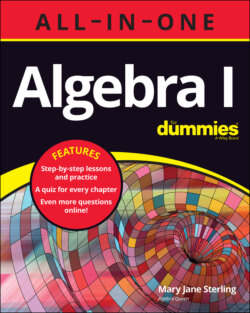Читать книгу Algebra I All-in-One For Dummies - Mary Jane Sterling, Mary Sterling Jane - Страница 25
Being precise with words
ОглавлениеThe words used in algebra are very informative. You need to know their exact meaning, because they convey what is happening.
An expression is any combination of values and operations that can be used to show how things belong together and compare to one another. is an example of an expression. Think of an expression as being the equivalent of a phrase or part of a sentence; you have some subjects and conjugates, but no verbs. You see how items are distributed over expressions in Chapter 9.
A term, such as 4xy, is a grouping together of one or more factors (variables and/or numbers) all connected by multiplication or division. In this case, multiplication is the only thing connecting the number with the variables. Addition and subtraction, on the other hand, separate terms from one another. For example, the expression has three terms.
An equation uses a sign to show a relationship — that two things are equal. By using an equation, tough problems can be reduced to easier problems and simpler answers. An example of an equation is . See Chapters 14 through 18 for more information on equations.
An operation is an action performed upon one or two numbers to produce a resulting number. Operations include addition, subtraction, multiplication, division, square roots, and so on. See Chapter 7 for more on operations.
A variable is a letter representing some unknown; a variable always represents a number, but it varies until it’s written in an equation or inequality. (An inequality is a comparison of two values. For more on inequalities, turn to Chapter 19.) Then the fate of the variable is set — it can be solved for, and its value becomes the solution of the equation. By convention, mathematicians usually assign letters at the end of the alphabet to be variables to be solved for in a problem (such as x, y, and z).
A constant is a value or number that never changes in an equation — it’s constantly the same. The number 5 is a constant because it is what it is. A letter can represent a constant if it is assigned a definite value. Usually, a letter representing a constant is one of the first letters in the alphabet. In the equation , c is a constant and x is the variable.
A coefficient is another type of constant. It is a multiplier of a variable. In the equation , a and b are coefficients. They have constant, assigned values and are factors, but they have the special role of multiplying variables.
An exponent is a small number written slightly above and to the right of a variable or number, such as the 2 in the expression 32. It’s used to show repeated multiplication. An exponent is also called the power of the value. For more on exponents, see Chapter 5.
Q. Identify the terms, coefficients, factors, exponents, and constants in the expression .
A. There are three terms, separated by the subtraction and addition symbols. In the first term, the 4 is the coefficient, and the 4 and are factors. The 2 is the exponent. In the second term, the 3 and the x are factors. The exponent 1 isn’t shown on the x; it’s just assumed. And the final term, the 2, is a constant.
Q. Identify the terms, coefficients, factors, exponents, and constants in the expression .
A. This expression has just one term. The P is a factor, and the parentheses form the other factor. There are two terms in the parentheses, and the exponent on the parentheses is nt.
9 How many terms are there in the expression: ?
10 How many factors are found in the expression: ?
11 Which are the variables and which are the constants in the expression: ?
12 Which are the exponents in the expression: ?
